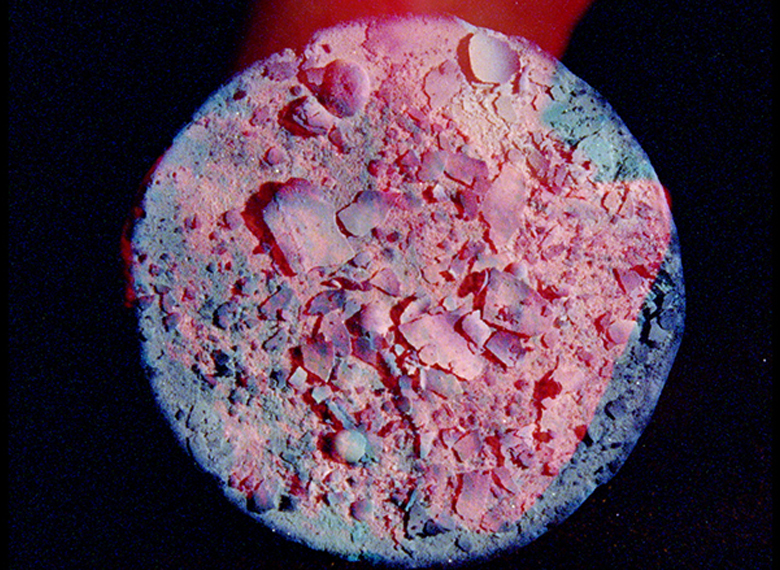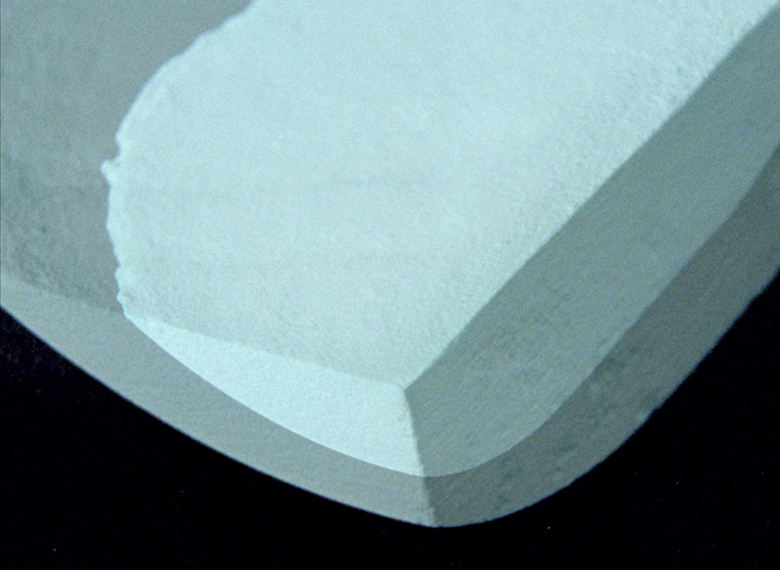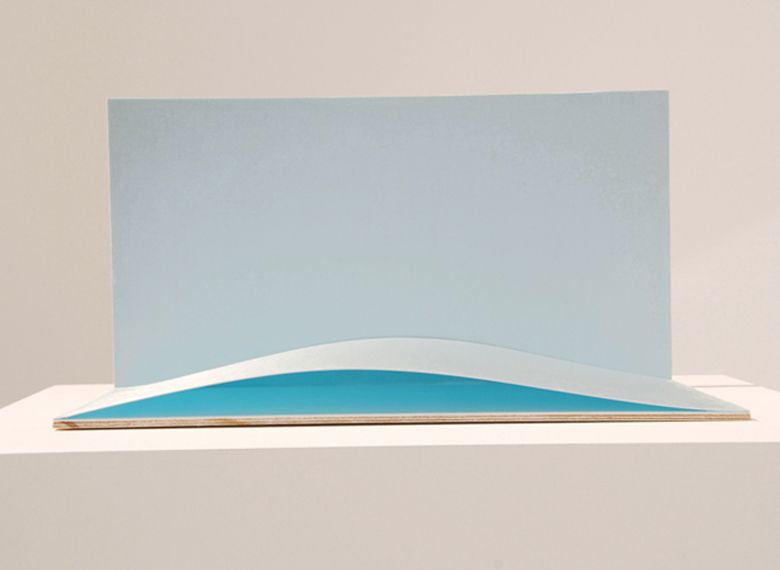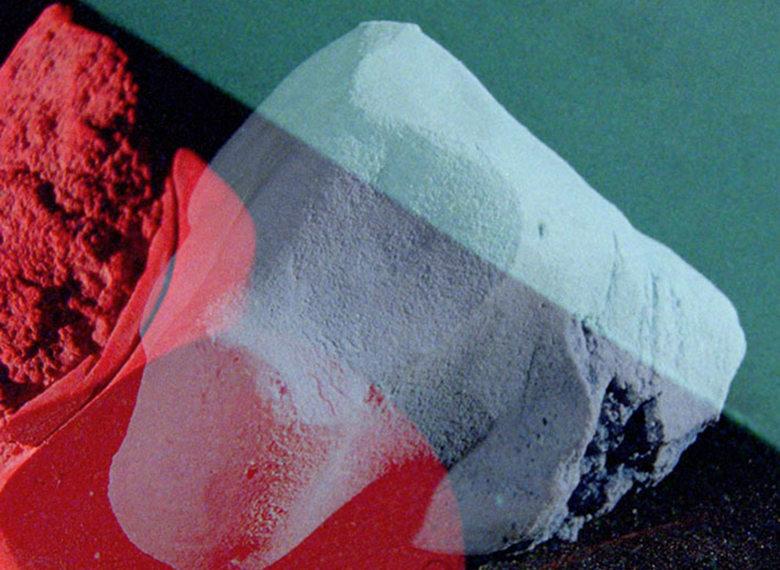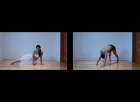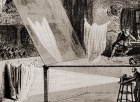Manuela De Laborde’s short 16mm film AS WITHOUT SO WITHIN (AWSW) takes its viewers on a contemplative, galactic journey through a world of illuminated plaster props. Her cosmic exploration of simple objects guides the viewer to a place of alert presence in, and appreciation for, the physical world. It slowly pushes inward, allowing for a meditation on our own being and body within the black stillness of the cinema.
Based now in Mexico City after having spent the last several years studying at Edinburgh College of Art and at CalArts in Los Angeles, De Laborde’s practice has evolved from gallery-based installations to cinema-based experimental film. We spoke over Skype following her recent film premiere at TIFF Wavelengths about her transition from visual art into film, the magic and frustration of working with celluloid, and her fascination with objects.
NICOLA WAUGH: Tell me about your experience at TIFF Wavelengths this week.
Manuela De Laborde: It was excellent! It’s the first time I've been to a film festival of that scale. When I started studying film at CalArts I was doing more visual art and exhibitions, so never went to festivals. My past films were shown at London MexFest Jihlava Documentary Film Festival, Antimatter in Victoria and Milwaukee Underground Film Festival, but TIFF is the first one I’ve actually been able to attend. AWSW will be screening at 25fps in Zagreb next weekend, and also at WNDX in Winnipeg, but I can’t be there—it’s just too expensive to fly from Mexico. I’ll be screening at the Morelia International Film Festival here in Mexico soon, so I will be able to attend that one.
I've been away from Mexico City for about nine years studying art and living in London, and then LA. I needed to settle somewhere, so I recently came back here. There seems to be less platforms for experimental film here, in comparison to the US, but I’m flexible. I want to get to know what there is and invite filmmakers to present their work here.
NW: What was it like to study at CalArts? There’s so much excellent experimental film coming out of there right now, especially on celluloid.
MDL: Yes, I really had no idea about film before CalArts. I finished art studies at the Edinburgh College of Art, and went into grad school wanting to do things a bit like Disney’s Fantasia, but with electronic music. I applied to CalArts only with videos I had made on my phone. I didn’t have any finished pieces, but I made it in to the program. I started out knowing absolutely nothing about experimental filmmaking; I didn’t even know the difference between digital and 16mm—I just called it all ‘film’.
NW: How helpful, or difficult was it to enter the world of filmmaking as a visual artist?
MDL: It was difficult for me to re-consider some thoughts, re-question some certainties and allow my work to shift somehow. It also remained indispensable, in that respect I stayed close to my background. I came from a conceptual and curatorial background, and it meant that everything I did, form and content, needed to be justifiable. I did tests for so many things, and if I felt that they didn't work with that concept, they got deleted immediately. And all my decisions in terms of theory are more fueled by critical theory than film theory. At the beginning when people saw my film they thought it was sculpture and photography, and that it had nothing to do with film. It finally became a film during the editing process and with the sound.
I came from a conceptual and curatorial background, and it meant that everything I did, form and content, needed to be justifiable.
NW: You’ve switched contexts very drastically, moving from showing in a gallery to showing in a cinema—how were you able to negotiate that in your practice?
MDL: It was a problem. At first it was a really big problem. It took nearly a year for me to break through. I don’t know if it was Donald Judd that said it first, but there was an interesting quote I remember: “No illusions, no allusions.” Illusion is a huge concern in art practice, because it can be interpreted as a trickery of some sorts towards the spectator. But you can’t even step into making a film if you don't want to create an illusion. It doesn't matter how simple your film is, just the fact that something evokes movement out of something still…it’s just so intrinsic to the medium that you have to accept it.
So, yes, I was confused, and had a problem. The two things that helped were that I felt that, emotionally, experimental filmmaking was giving me more than the art world had. I think art is still great, but our sensibility to experience art and the context around it maybe lacks a bit of strictness, and we have too many distractions. You know, having this cathartic experience, this communication coming through you seems harder to find. For me, art had become more about reading and befriending notions and concepts, and if the reading of it was very predictable, then the work was not interesting. If it caused a problem then it was more interesting.
With experimental films, I felt like I would start the film, and have my thoughts quickly and completely conclude about it like, ‘I know what this is about.’ It has a provocative notion. And then the film would continue, and maybe a contradiction would appear, and you would be like, ‘Oh, that just contradicted the thought I just had,’ and then there is a third element that gets produced in your head—its too fast for you to grasp it. And then you realize that you stopped thinking normally, and maybe for a moment you're just seeing. And then suddenly you drift off to think about other things.
At the end, it doesn’t matter—someone's life might be held by more urgent matters, like lifestyle and necessities, and someone else might be caught up in a love they had that is not concluded, or friendships that have gone lost, or just feeling alone. There’s just time and space to be there, with yourself, because you have no choice. The strictness of the theatre fixes you there, and you either stay with the film or with yourself or both. That's why I'm totally cool with people falling asleep in movies. Some people think it's not fair, but if it’s an experimental film with broken narratives anyway if you fall asleep, it’s broken even more.
NW: Yes, I love this. As a programmer I can sometimes feel the discomfort in the room when people aren’t getting the narratives they’re expecting. But when they finally accept it, they break through to this incredible meditative place where you can just drift. Your film in particular is so pleasing to look at, but there are so many changing reference points that you finally let yourself let go and stop trying to follow things in a linear way.
MDL: But to actually construct and evoke this is super complicated. I was hoping I could cause this but was really not that sure how one works towards that. The beginning of the film was very much the beginning of my process. I started by framing the objects in a simple, centered way. I knew what constructed atmosphere, but just on the most basic level, like the objects and the framing, but it took me some time to understand how they worked. I went deeper with new frames and cuts, and also with the sound, which I worked on with my sister, Camila de Laborde, over a year. She’s a singer and musician, mainly in electronic music, so she took a new angle on experimental sound, which gave it a mix of aesthetics. She was great at seeing my vision. We wanted to play with the cinematic sync—joining it and moving away from it, and making it uncomfortable. It needed to be very abstract; I wanted the sound to feel finite at times, being, like small events, and also at times like becoming, in order to play with the sense of time, and also to snap you out of the visual experience, bring you back to the here and now.
NW: Was this your first time working on film?
If it caused a problem then it was more interesting.
MDL: Yeah, I mean, I did some exercises and a one-minute film for some classes before, but I chose to learn more because I wanted to take my time doing something—I knew the process would be fulfilling to me.
I had just left London, and I found the arrival to LA very complicated and emotionally disrupting, so I needed practices that would be self-assuring and would give me space. It wasn’t the filming so much, but the time in the darkroom that I loved. And yes, I got super excited by the materiality. There was some kind of constant vitality within the film grain that reminded me of internal vision experiences—when you hallucinate. When you can see how something functions on the inside, these tiny things constantly moving. It was also very reassuring that something light-concerned, which is so intangible, had this parallel, very tangible translation. And of course, it was my thesis, and three years abroad. You're getting support from your parents, friends and teachers—you want that tangible thing to show for it, a lasting object.
NW: So, using film was new, but working with objects is something that you've been doing for a long time. Why do you think you're so drawn to objects?
MDL: The object has always been there, because I always need to do things with my hands. My head and my thinking always go towards vision—how we see things, and the perspective of them, but then the doing is very handy for me. So, in that sense, the object is useful, but I tend to use it in a way that points to something else. For my show MAQUETTES at Generator Projects in Scotland, the objects started with architectural visions I had and put in my sketchbook. And then the project evolved into making them with cardboard, plywood and things I had at hand. These little objects were just meant to be proposals for something larger. But then I was like, ‘Actually, I don't want to be working with a factory to produce these big established things. I just can't afford it.’ I started resenting such practices, because they were so hyped by more established institutions. And I was like, ‘Well, I want to talk about this, but I don't want to do that type of work, so I'll just propose it.’
In terms of my film work, it’s hard to separate from the object. There are films that try to be completely object-free, using a macro lens or something, but you’re still looking at something. We seem to have this desire to escape our reality. And I decided I didn’t want to distort reality; I don't want to rely on the mechanics. I wanted to make objects that are props of images of abstraction. But these things became an entity in their own right, and I had to accommodate my thinking and my project to give them some space. At first I wanted to get as close as possible to them, but didn’t want to to use a macro lens and a shallow depth of field, but decided they needed to be a bit graphic, more flat. I filmed with a telephoto lens, and extension tubes—which normally don’t go together, but I made it work and could handle the object at arm’s length while still flattening them.
NW: There’s definitely a distance—kind of a feeling of traditional documentation—at least at first. You don’t feel like you’re there with the objects. But as the film progresses, there's more editorial interventions with things like layering, and the pace changes—almost more human, more emotionally charged.
MDL: Yes, there's the object, and there's the image-object, and I wanted people to think about the image-object. But these things had become such temperamental beings, like little divas. Everybody was like, ‘Wow where are these objects? Can we see them?’ and I was like, ‘They actually look very different in real life.’ I wanted to make it about an image-object, and I thought that the only way these objects will stop being so real, is if I put them on top of each other in the editing process. Objects in reality can't sit on top of each other like this. Making it about the image-object meant that I could have fun with the existence of these things by placing them together. But, the moment it starts layering up was also a moment where I personally started stumbling with the film a little bit. It was so difficult to work with and I kind of started losing it…
NW: But this is also an act of exercising your power over it too, right? Saying, ‘They can't exist on top of each other, but I'm going to make them,’ and then you have agency still—the objects are not in control anymore.
MDL: Exactly, yes. I could have made it very neat throughout. There's a moment where there are more cuts and it's not a controlled flickering. The images are super-imposed with each other, but at a clumsy rate. That was much more like, ‘Let's see what it looks like,’ kind of thing. And the more I edited, the bigger it grew. It was like Alice in Wonderland: little doors, many little doors. And I remember coming to my supervisor and saying, “This is not only anal, but it's like a cancer.” I had 70 takes, now I have 250 takes. It was the most psychotic thing—you’re tightening, but it’s growing. It was so hard to make it 25 minutes long.
NW: Tell me more about the conceptual motivation behind AWSW. I keep thinking of Jane Bennett’s book Vibrant Matter. She wrote about trying to dissolve the difference between subject and object.
I believed in the myth of the art being something that talks to you and you talk to it.
MDL: Yes, I definitely read that, and also was given a book called The Tears of Things by Peter Schwenger. This book was great because he talked about the thing. In some senses, it's quite a basic book, but it was very interesting; I had never heard someone speak about the difference between the object and the thing, and what makes something a thing. He also talks about how your relationship to a thing has already bound it, either because you have projected some memory, or some history, or a myth on to it. He draws attention to the very human aspect of things.
There was also Martin Buber’s, I and Thou, which talked about I-it relationships. The human being has two ways of relating: I-it or I-you. In the I-it relationship, because you're speaking to an it, makes you open to the negation of the I altogether. So, your own I is less self assured in the conversation, in the relationship; even if you're the I in the conversation, you're kind of opening up to its possible negation, and your relationship is just a little bit more flat.
For me, I was trying to understand things. I was alone in this big suburban town. I didn’t have that entourage of friends that you normally have, at first. I needed something that would fulfill me. I believed in the myth of the art being something that talks to you and you talk to it.
NW: And you had this relationship with the film itself?
MDL: Yeah. I was very much like, ‘Game on—this is what you say, this is what you want.’ It had a life of its own, and in that sense, even aesthetically, I had problems with the fact that it looked like a tribute to modernism, but I realized, ‘You’re outside me, and beside me, and this is what you give me and this is how I respond.’
And Martin Buber writes about it in such a gorgeous way. It's not the normal approach to object-subject theory, and all this was very new to me during my studies. There was a mix of other things as well: the writings of Clarice Lispector, and philosophy classes on Merleau-Ponty, and so on. I think that there are more tough readings about it, and more profound readings about it, but I didn't get that far. Its like the film introduced me to these things, rather than me coming towards it in a certain way.
NW: It can really take you down a hole when you get far into this. And that's what's so wonderful about the film, is that it goes there, but you don't need to say anything directly. And, of course, the title speaks to that as well.
MDL: Before I came up with the title, I was talking to my psychologist about the film, and he said, “You are working on it, but it’s doing its work on you.” He was very interested in an alchemical perspective of things.
The phrase normally goes, “As above so below, as within, so without.” It's about this sort of indifference or sympathy of the world to echo itself at different points of view, like the top of a tree looks like its roots. The buzz and movement you feel inside you is outside of you, and you are living, and the thing is living. I changed it to AS WITHOUT SO WITHIN because I wanted to separate from this trajectory, to separate it from the original, and also because that's how my trajectory actually went; it was from seeing things outside of me in the theatre—thinking of the frame and the blackness.
AS WITHOUT SO WITHIN premiered in September at TIFF Wavelengths and went on to screen at 25fps Festival in Zagreb, Croatia where it won the Grand Prix, and at the WNDX Festival of Moving Image in Winnipeg in October where it won the Jury Prize for Best International Work.
“An object is a slow event” is a quote from Stanley Eveling (1925-2008), playwright and professor of existential philosophy at the University of Edinburgh, Scotland.
Barbara Kirshenblatt-Gimblet, “The museum as catalyst” (lecture, ICOM Sweden, the Swedish Museum Association and the Swedish Travelling Exhibition//Riksutställningar, Vadstena, Sweden, Sept 29, 2000). https://www.nyu.edu/classes/bkg/web/vadstena.pdf.

